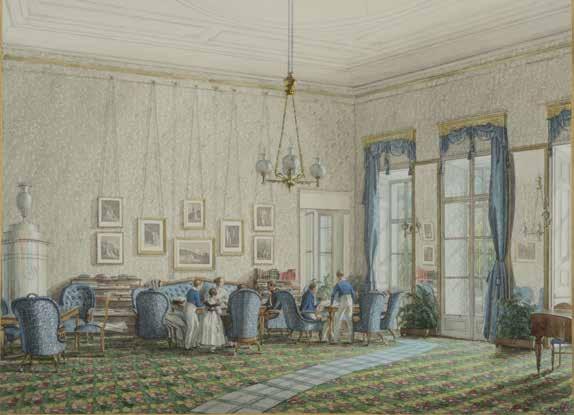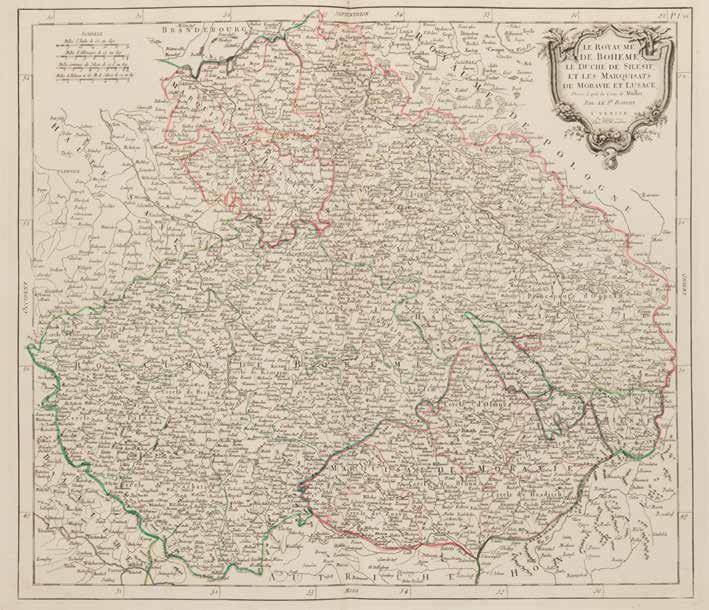
5 minute read
2. Lute Playing and Collecting in the Lobkowicz Family
find its way into his new symphony, which also explores the nature of heroism. Originally Beethoven thought to dedicate the Third Symphony to Napoleon Bonaparte, who was at first a hero to many who held democratic ideals. Beethoven was deeply disillusioned, however, when in 1804 Napoleon declared himself Emperor. He scratched out Napoleon’s name on his title page and instead dedicated it to his sympathetic and generous patron, Prince Lobkowicz. All the Lobkowicz resources of space, money and personnel were put at Beethoven’s disposal when it came time to prepare his unprecedentedly massive, difficult new symphony for performance. The Lobkowicz palace became Beethoven’s workshop as he directed the first rehearsals of what would eventually become known as the Eroica Symphony. A surviving account record dated June 1804 shows the hiring of 22 extra musicians, including the third horn player necessary for the Eroica, added to the six string players already on the Lobkowicz payroll. After private performances of the work in Lobkowicz’s Bohemian castles that fall, the symphony was offered in a January 1805 academy in the splendid hall of the Vienna palace.
In 1806 Beethoven completed a staggering amount of important new music: the Fourth Piano Concerto, the three ‘Razumovsky’ Quartets, the Violin Concerto and the Fourth Symphony all came
Account of expenses for extra musicians, including third horn required for Beethoven’s Third Symphony, approved by Prince Lobkowicz on 11 June 1804. The Lobkowicz Collections.
to fruition that year. In late summer, Beethoven visited the Silesian castle of Count Franz von Oppersdorff. An enthusiastic amateur, Oppersdorff kept a private orchestra that played the composer’s Second Symphony during his stay. Oppersdorff commissioned a new symphony from him, and Beethoven obliged with the Symphony in B flat. Though dedicated to Oppersdorff, the Fourth Symphony received its first Viennese performance in a concert hosted by Prince Lobkowicz. Contemporary reviews mention that in March 1807 two concerts devoted entirely to Beethoven’s music were held in the Lobkowicz palace; included were all four of his symphonies, a freshly composed overture for Heinrich von Collin’s tragedy Coriolan, the newly completed Fourth Piano Concerto and selections from his opera Fidelio. The Lobkowicz music collection preserves the parts for the Fourth Symphony that were used by the orchestra in those first rehearsals and performances. The manuscript parts were produced a month or two ahead of the concerts by court theatre copyist Wenzel Sukowaty (1746–1810), and Beethoven’s hand also appears in them, making corrections and adjustments for various instruments in the orchestra. Given the historic nature of the events, a few players even recorded their names on their parts. For example, the names of flautist Karl Scholl, a member of the court orchestra, as well as that of contrabassist Anton Grams from the orchestra of the Theater an der Wien – both musicians liked and trusted by the composer – appear. The extraordinary character of these concerts, presenting so much new music by a single composer, and music that posed so many unusual physical, intellectual and emotional challenges to player and listener alike, cannot be overstated. The role of Prince Lobkowicz and his ensemble in facilitating these performances was no doubt recognised by Beethoven, who within the next few years
Operas and Opera Singers in Lobkowicz Theatres
At the turn of the 19th century the 7th Prince Lobkowicz launched a brief but dazzling era of operatic performance in private theatres that he installed in three of his residences, including his palace in central Vienna and two Bohemian castles, Roudnice and Eisenberg. Like many of his aristocratic friends and relations, Lobkowicz avidly attended the opera in both Prague and Vienna, where he held life-long subscriptions to boxes at the court theatres. But his enthusiasm for opera led him to an intense personal cultivation of the art that was unmatched in his time by other patrons outside royal courts. Archival evidence shows that 1799 inaugurated this era of theatrical activity on the Lobkowicz estates in Bohemia. A newly hired theatre painter and designer, Caspar Melchior, took charge of ordering sets, decorations and stage machinery. Musicians and singers were employed from the Estates Theatre in Prague, choristers arrived from Prague’s Loretto Church, and village musicians from the districts around Eisenberg and Roudnice took part. Carriages and horses were deployed to take the many personnel from place to place, new quarters were erected at Roudnice to house them, and many of them were paid in food and beer as well as cash. Antonio Cartellieri (1772–1807), a composer and violinist in Lobkowicz employ, provided a new opera – Angarda, regina di Boemia – for performances in October at both castles. Prince Lobkowicz’s Kapellmeister, Anton Wranitzky, hired extra musicians and rehearsed the orchestra for these performances, and supervised music copying as well as repairs and transportation for musical instruments. This explosion of activity, which involved hundreds of people and massive expenditure, set a pattern that would develop and expand throughout the next several years.
overleaf: Roudnice Castle, showing the theatre’s front and side windows in the wing left of the clock tower. Painting by Carl Robert Croll (1841). The Lobkowicz Collections.
Libretto for Antonio Salieri’s opera Axur, re d’Ormus, published privately for Prince Lobkowicz’s theatre by imperial court printer Matthias Andreas Schmidt. The Lobkowicz Collections.

The Lobkowicz palace in Vienna also became a site for opera production. In March 1799 an opera by imperial court composer Antonio Salieri, Axur rè d’Ormus, was presented there, though apparently unstaged. But by 1802 special carpentry and furnishings had been ordered to fashion a small theatre within the palace; the distinguished court stage designer, Lorenzo Sacchetti (1759–1836), supplied sets; and a wardrobe manager from the court theatre outfitted one of the lead singers, tenor Antonio Brizzi (1774–1830), with his costumes. Two works presented that year under these new conditions were Paisiello’s already venerable opera Il barbiere di Siviglia and a more recent creation, La testa riscaldata, by Ferdinando Paer. Account records show that Prince Lobkowicz had hundreds of librettos printed for distribution to his audiences, and the imperial court copyist, Wenzel Sukowaty, was responsible for producing all the music – scores to be used by the director and prompters, and parts for all the singers and





